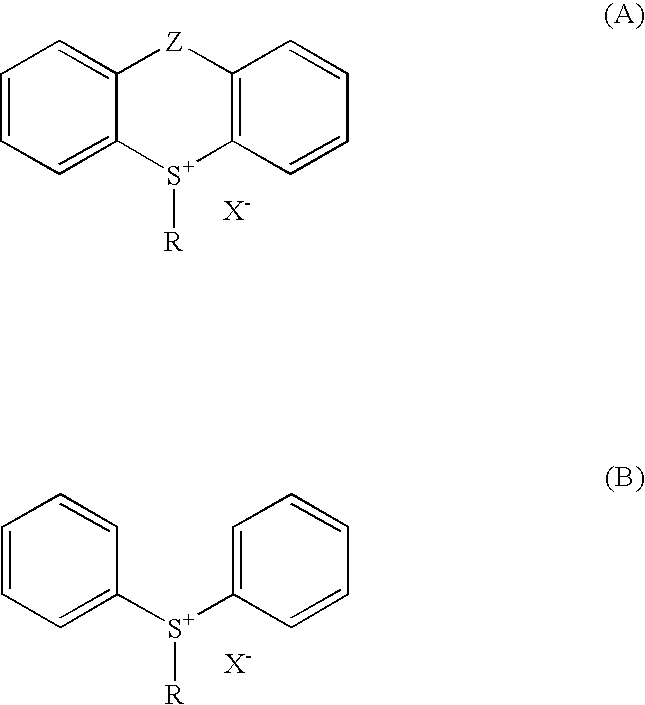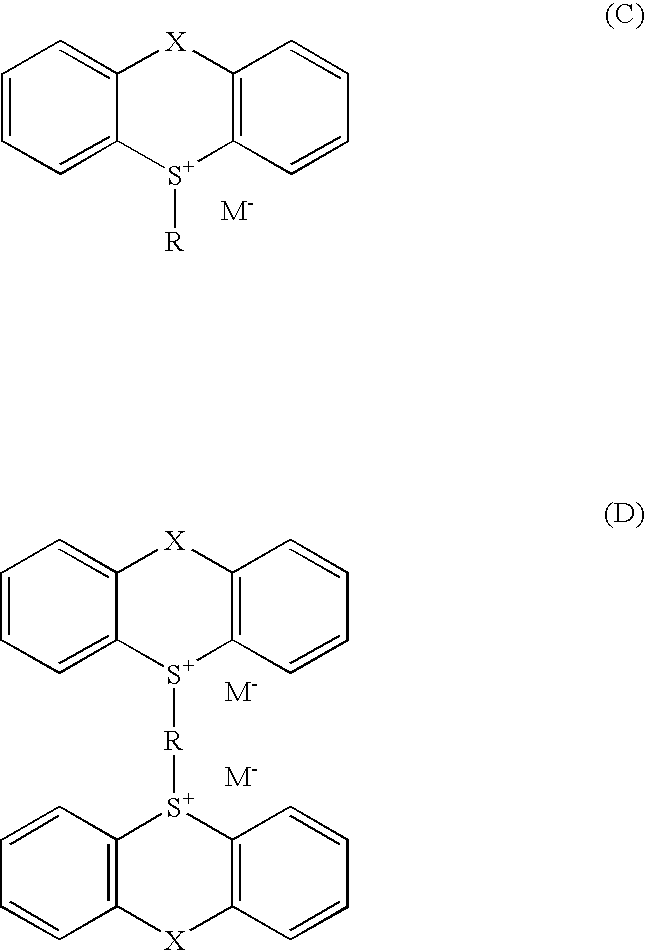Sulfoniun salts, methods for their preparation and use thereof as phtoinitiators for radiation curable systems
a technology of sulfonium salt and radiation curable system, which is applied in the direction of instruments, group 1/11 element organic compounds, and group 4/14 element organic compounds. it can solve the problems of high risk of cation-radical perchlorate due to its instability, and the use of sulfonium sal
- Summary
- Abstract
- Description
- Claims
- Application Information
AI Technical Summary
Benefits of technology
Problems solved by technology
Method used
Image
Examples
example 2
4,4'-bis(thianthrenium-9-yl)-diphenylether dihexafluorophosphate
[0131] To a solution of diphenylether (3 g), thianthrene-9-oxide (4.06 g) and tetrachloroethylene (200 g) aluminium chloride (7 g) was added in one portion. The suspension was stirred at a gentle reflux for 75 minutes. Then tetrachloroethylene (60 g), thianthrene-9-oxide (4.64 g) and aluminium chloride (8 g) were added maintaining the same condition of reaction. To complete the reaction 0.6 g of thiantrene-9-oxide were further added and the reaction mixture was stirred under reflux for 30 minutes more. The mixture was then poured into water, filtered and washed with ethyl ether. The aqueous phase was added drop wise in a solution of 8.5 g of potassium hexafluorophosphate dissolved in 2 litres of distilled water. The solid precipitated from the solution was collected by suction filtration and washed with water. The filter cake was dried to give a white solid (14.6 g) in a yield of 93.7%.
[0132] 1HNMR (DMSOd6): .delta.(ppm...
example 3
4,4'-bis-(thianthrenium-9-yl)-diphenyl dihexafluorophosphate
[0134] A mixture of biphenyl (0.77 g), thianthrene-9-oxide (1.16 g), aluminium chloride (2 g) and tetrachloroethylene (85 g) was stirred at a gentle reflux for 75 minutes. Then tetrachloroethylene (22 g), thiantrene-9-oxide (1.33 g) and aluminium chloride (2.64 g) were added maintaining the same condition. After 75 minutes dilute chloridric acid was added slowly. The extract was treated with a solution of potassium hexafluorophosphate (2.5 g) dissolved in 100 g of water. A white precipitate (0.1 g) was obtained with a m.p. of 140.degree. C.
[0135] 1HNMR (DMSOd6): .delta.(ppm): 7.28-7.38 (m,4H); 7.76-8.00 (m,12H); 8.01-8.13 (m,4H); 8.55-8.66 (m,4H)
[0136] MS: 729 (M)
example 4
4,4'-bis-(thianthrenium-9-yl)-diphenylsulfide dihexafluorophosphate
[0137] a) A mixture of 10 g of fluorobenzene, 0.46 g of thianthrene-9-oxide and 1.6 g of aluminium chloride was stirred at a gentle reflux for 90 minutes. After cooling the mixture was poured into water and the organic phase separated. The aqueous phase was filtered and treated with a solution of 0.5 g of potassium hexafluorophosphate in 10 g of water. The precipitate was filtered off and washed with water, then dried under vacuum to give 0.6 g of a white solid (66%).
[0138] 1HNMR (DMSOd6): .delta.(ppm): 7.25-7.35 (m,2H); 7.43 (t,2H); 7.82-7.98 (m,4H); 8.08 (d,2H); 8.58 (d,2H)
[0139] MS: 311 (M)
[0140] b) A suspension of 0.14 g of thiophenol in 2.5 ml of a 0.5 N solution of potassium hydroxide in methanol was stirred at reflux for 15 minutes. After cooling 0.57 g of the compound obtained in step a) was added and stirred at room temperature for 60 minutes and then at gentle reflux until the colour was clear. The solvent ...
PUM
| Property | Measurement | Unit |
|---|---|---|
| molar ratio | aaaaa | aaaaa |
| molar ratio | aaaaa | aaaaa |
| molar ratio | aaaaa | aaaaa |
Abstract
Description
Claims
Application Information
 Login to View More
Login to View More - R&D
- Intellectual Property
- Life Sciences
- Materials
- Tech Scout
- Unparalleled Data Quality
- Higher Quality Content
- 60% Fewer Hallucinations
Browse by: Latest US Patents, China's latest patents, Technical Efficacy Thesaurus, Application Domain, Technology Topic, Popular Technical Reports.
© 2025 PatSnap. All rights reserved.Legal|Privacy policy|Modern Slavery Act Transparency Statement|Sitemap|About US| Contact US: help@patsnap.com



